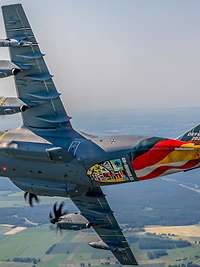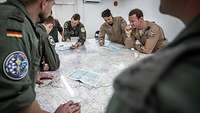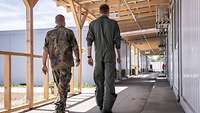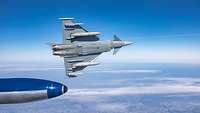
Air Defender 23
Multinational air operation exercise in Europe


The morning is dawning and the wind is blowing furiously over the airfield while pilots of the German Air Force are preparing for their upcoming mission. It will be the first one within the scope of the German-led Air Defender 23 air force major exercise, in which 25 nations participate with approximately 250 aircraft. But what are the exact prerequisites and what preparations are made?

The essential thing is precise planning of the mission in minute detail: For this purpose, the aircrews brief one another in the Fighter OPS until just before takeoff.
Bundeswehr/Jane SchmidtThe centrepiece of any planning for missions to be flown is the Air Tasking Order (ATO), a detailed document that describes the tasks and responsibilities of the individual pilots and aircrews during the air operations to be conducted. As an element connecting the strategic objective and the tactical execution, it plays a critical role in the planning and conduct of air missions within NATONorth Atlantic Treaty Organization and hence the Air Defender 23 exercise as well.
Based on the ATO, the Eurofighter pilots – who wear flight suits and multifunctional head equipment assembly (HEAHead Equipment Assembly) helmets that allow them to keep an eye on their flight data and the events taking place in the airspace and at the same time enable them to direct the aiming system via voice recognition and control – enter the cockpits and prepare for takeoff. Their mission is clearly defined: airborne protection of friendly forces, which means achieving air superiority in the joint operations area. The pilots are tasked to identify potential targets, launch attacks, and supply real-time information to all forces involved in the mission, both on the ground and in the air.
The ATO is prepared in a complex process and relies on precise planning. In the Fighter OPS, the combat information centre at the air base, the tactical preparations are joined up. And this is what happens at Jagel Air Base at present as well. Here, the German hosts – 51 Tactical Air Wing Immelmann – have furnished three briefing rooms and three planning rooms, one for each area of the exercise. This is where the aircrews assigned to the individual missions of the respective scenario come together. The sequence of the instruction, or briefing, always follows the same schedule: First, the weather officers report. After the basic situation with its up-to-the-minute peculiarities has been delivered, the aircrews brief one another. From now on, it gets serious – the jets take off and approach the exercise area under control of the assigned Control and Reporting Centre (CRC). The pilots now follow the air routes specified in the task order – the ATO.

Mutual exercises and training enable the pilots to coordinate details with one another and cooperate efficiently
Bundeswehr/Jane SchmidtThe ATO defines clear structures and requirements to ensure cooperation and coordination between the aircraft involved and with ground forces and naval units as well. It may comprise up to 20,000 lines of text – 50 lines per page, written in typewriter style in a standard font size. The ATO includes, among others, flight altitudes, coordinates of rendezvous points with tanker aircraft, and the enemy forces anticipated. Reading the ATO, apprehending the individual mission, understanding and comprehending their tasks, helps the pilots successfully accomplish their mission. The pilots must manage not only the technical and tactical aspects but also the pressure to make decisions in an environment that is both dynamic and dangerous.
In this context, communication is critical. The pilots use their assigned frequencies and codings to ensure that they communicate in an effective manner with one another and the ground control centres. The pilots remain alert in flight, permanently scanning for potential threats. Their situation awareness is keen as they are watching the sky. When they need to handle potential hostilities, the rules of engagement specified in the ATO help them make tactically correct decisions in line with the overall situation. Each flight day is preceded by a planning day. The exercise areas in Germany require enormous coordination. Each pilot must exactly know what to do as there are many dynamic processes in the air which the pilots must analyse and classify in a precise manner. In the preparation phase, this means: Whenever there is the slightest uncertainty, the aircrews will come together again and coordinate details with one another until the mission is clear.
When reaching their target area, the pilots cooperate closely with an AWACSAirborne Early Warning and Control System airspace reconnaissance (recce) aircraft. This aircraft is capable of detecting enemy targets from a distance of more than 400 kilometres and allocating them to friendly jet aircraft. Recce aircraft and Eurofighters coordinate their actions in order to precisely engage targets and thus keep the sky clear of enemy forces.
Their mission is both challenging and intense. The pilots fly for several hours, any time ready to respond to unexpected situations and act quickly. They are aware that their success depends on how well they accomplish the missions specified in their “mission bible”, the ATO, and how exactly they cooperate as a team.
To cut a long story short: The ATOs are the backbone of NATONorth Atlantic Treaty Organization air operations and the pilots are the heroes in the sky who make these missions a success. The task orders become more and more complex and demanding since new technologies and tactics are incorporated. The pilots must constantly familiarise themselves with latest developments and continually improve their skills in order to meet the challenging requirements. Intensive training programmes and simulations are conducted in order to provide realistic scenarios and prepare the pilots for various mission scenarios. With their courage, determination and expertise, they will also play an important role in the planning and execution of military air missions in the future. NATONorth Atlantic Treaty Organization’s air forces and their allies continue to strive to advance their capabilities and enhance their effectiveness in order to cater for the changing threats. Cooperation and coordination between the member states of the Alliance are critical to maximise the effectiveness of air operations. Mutual exercises and training enable the pilots to coordinate details with one another and to cooperate efficiently. This is supported by a common language, uniform standards, and suitable technology. The exchange of proven procedures and the harmonisation of communication and coordination processes ensure that NATONorth Atlantic Treaty Organization air forces stand as one and are capable of successfully accomplishing their tasks. Another important component in planning a military air mission is the evaluation following the operation. By thoroughly analysing the actions carried out, the objectives achieved and the lessons learned, areas of improvement can be identified and integrated into future ATOs. This continuous learning curve contributes to further enhancing the efficiency and effectiveness of air operations.

A Eurofighter turns towards the enemy: Each pilot must be aware of his or her role to be able to quickly respond to any possible situation.
Bundeswehr/Jane SchmidtIt is important to note that planning a military air mission is a complex process that depends on many factors. Besides the ATOs, political decisions, strategic objectives, geographic conditions and the resources available must be taken into consideration as well. Planning a mission requires a high degree of expertise, close cooperation between the various functional areas, and a thorough analysis of the situation.
All in all, planning a military air mission continues to be a challenging task that requires comprehensive preparation, coordination, and cooperation. The ATOs play an important role in this since they define the framework and the instructions for mission execution. The pilots of NATONorth Atlantic Treaty Organization’s air forces are key players who successfully implement the missions with their expertise, discipline and courage and thus contribute to both security and defence of the NATONorth Atlantic Treaty Organization member states.
After the mission has been completed, the pilots return to base. But the day is not over yet as the follow-up of the exercise – the debriefing – is due. Each pilot must prepare a detailed report of the actions and observations during the mission. These reports are highly important as they are not only used for documentation purposes but also to analyse and evaluate the mission. At the same time, the commander of the joint operations area – the air boss – evaluates the check files. These files are data sets, similar to a black box on a civilian aircraft, that are read out and combined to obtain a common situation picture. With their help, the aircrews evaluate the mission results during the debriefing. The pilots exchange their lessons learned, discuss weak spots, and look for options for improvement. The insights gained in these discussions are incorporated in the development of new tactics, techniques and procedures in order to render future missions more effective.
by Thomas Skiba
Multinational air operation exercise in Europe